¶ 1 Leave a comment on paragraph 1 0 In his 1971 essay, “Four Faces of Bibliography,” Fredson Bowers issues an urgent call for the preservation and cataloging of newspapers.1 “This must be a co-operative enterprise, government or foundation funded,” he argues, “and destined for preservation in a computer bank. And it must be started soon, newspaper by newspaper, year by year, through the whole nineteenth century before these newspapers crumble to dust. . . . Time is running out, I warn you. These newspapers are disintegrating and they have immensely valuable material locked up in them, unknown and untouched.”2 Little might Bowers have anticipated that the “computer bank” would become mass digital databases with thousands of serials titles at a researcher’s fingertips. But the reality that Bowers describes—one in which newspapers, or serials more generally, are in urgent need of preservation and classification—persists even in the digital age. Because the majority of nineteenth-century serials were short-lived; because they changed hands, titles, and publishers; because they were often discarded; because they were used for so many other purposes besides reading (e.g., wrapping fish); because the archive is vast and varied, the work of preserving and cataloging U.S. serials is messy.3 Indeed, even as digitization has created unprecedented access to serials, the rhetoric of loss, urgency, and disorderliness remains. As Ryan Cordell observes, “digitized periodicals remain voluminous, messy, provocatively difficult,” and the data they produce “wonderfully chaotic.”4 Scholars are perpetually “at the beginning of a new era of discovery,” Patrick Leary describes, facing the “odd bits dredged up from the unplumbed depths of the newspaper and periodical press,” and wrestling with the “abundance” of material that we can access digitally.5
¶ 2 Leave a comment on paragraph 2 0 The wonderful chaos, the mess, the abundance, the depths, the urgency of digital serials research could be a deterrent to working with them in the university classroom. After all, how do we teach both the process of dredging the mass of material while acknowledging the media history of the very digital databases in which students conduct their searches? How do we simultaneously familiarize students with methods in digital periodicals research and defamiliarize the results that they see on their screen so that they become aware of their constructedness? The following case study offers an approach to answering these questions through collaboration and remediation.6 Indeed, as the editors of the digital archive BLT19: Nineteenth-Century Business, Labour, Temperance, and Trade Periodicals have observed, “Because periodicals are inherently collaborative, they are particularly suited for collaborative learning approaches.”7
¶ 3 Leave a comment on paragraph 3 0 The project originated in the summer of 2015, when Lindsay DiCuirci, co-author, was slated to teach an advanced-level English seminar, “Women and American Periodicals” at the University of Maryland, Baltimore County, and Molly O’Hagan Hardy, co-author, was serving as director of digital initiatives at the American Antiquarian Society (AAS) in Worcester, Massachusetts. After casually discussing some ways that Lindsay might incorporate a digital humanities project into her assignment sequence, Molly proposed a semester-long collaboration on a curated, topical digital exhibition that would feature items from the AAS collections and make use of AAS’s Omeka install. In selecting the exhibition topic, we considered which units from the syllabus—covering women’s writings in American serials from roughly 1790 to 1900—might be best suited to highlight AAS collections in a digital format, bringing to the fore an important chapter in women’s literary history that had largely played out in labor serials. Mill women specifically harnessed the form of the serial to publish their literary work, songs, and memoirs and to redress their complaints, but the women were also the subjects of think pieces, critiques, and romantic or tragic fictions in general-interest serials. Thus, the serial became an indispensable platform for mill girls looking to control their image and advance their cause in the press. Some of the serials we highlight in the exhibition are widely digitized and free, others behind paywalls, and others unavailable outside of the stacks of the AAS. Mill girls in nineteenth-century print proved fruitful both as a topic in women’s literary history and as a case study in serials access and cataloging. After selecting this topic, Lindsay designed a detailed set of assignment guidelines for locating and organizing primary and secondary sources, designing and customizing the site theme, drafting essays and item labels, and constructing site navigation. Students worked in small groups both in class (which met once per week, with half an hour per session dedicated to exhibition work) and outside of class on each of three main exhibition sections: Activism and Reform, Culture, and Conditions. Students chose these three major themes after two weeks of familiarizing themselves with mill girls’ serials in digital archives. Despite a carefully designed list of weekly tasks, much of the work unfolded organically, with students learning, troubleshooting, and experimenting through each step of the process. The end result of this fifteen-week collaboration is “Mill Girls in Nineteenth-Century Print,” a digital exhibition hosted on the AAS website, focused on coverage in newspapers and periodicals (ca.1834–1870) of the huge influx of women into the industrial workforce [Figure 1].8
¶ 4 Leave a comment on paragraph 4 0
¶ 5
Leave a comment on paragraph 5 0
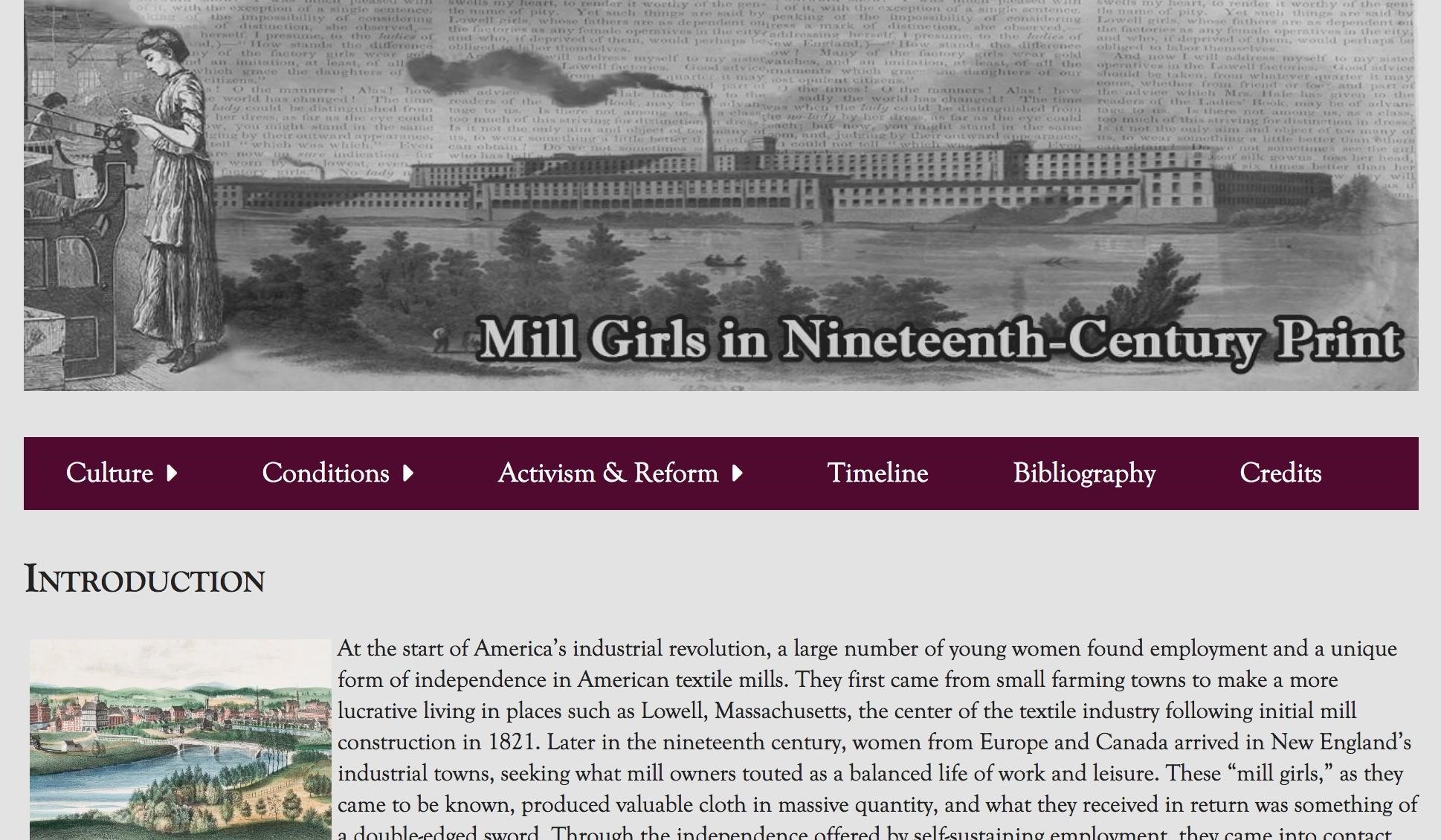 Figure 1. Home page for the online exhibition, built in Omeka. http://americanantiquarian.org/millgirls/.
Figure 1. Home page for the online exhibition, built in Omeka. http://americanantiquarian.org/millgirls/.
¶ 6 Leave a comment on paragraph 6 0
¶ 7 Leave a comment on paragraph 7 0 Because one of the goals of the collaboration was to use existing search-and-discovery resources for nineteenth-century serials and render them anew in an online exhibition, we could not simply tell the students that digital serials are “voluminous and messy” and leave it at that. Instead, we had to make meaning from the disorder and, in many instances, figure out what is “messy” about digital serials in the first place. Explaining the apparent contradictions or inconsistencies in the articles they found, in what the serials were named, in where and when they were produced, all became as integral to building the exhibition as deciding upon the organizing themes and which items to feature within each theme. Further, our project turned a spotlight on what Paul Fyfe calls the “intermediary state between source object and digital surrogate in the cloud,” the work of twentieth-century collecting, cataloging, and remediating that, in many ways, made the digital possible.9 The twentieth-century information architecture created and implemented in special collections libraries invited our scrutiny at each step of the collaboration. The physical distance between the UMBC students and the AAS, the varying degrees of access to materials, the inherent difficulties of working with digital serials, and the task of remediating print objects for the purposes of a digital exhibition required a reconceptualization of what it means to teach in and about digital resources.
¶ 8 Leave a comment on paragraph 8 0 During much of the semester, Lindsay’s students worked on locating and selecting the printed materials they wanted to feature in the exhibition as well as on providing item-level metadata and discursive descriptions. Because we could not share the physical space of the reading room, this remote collaboration necessitated bibliographic control over the many iterations in which these periodicals existed in print, on the open web, and in proprietary databases. AAS’s serials fall into four categories: not digitized, internally digitized and freely available, or digitized in one of two places: EBSCO’s AAS Historical Periodicals Collections or Readex’s America’s Historical Newspapers. This means that many of the AAS’s titles are behind paywalls, but the AAS retains the right to reproduce a certain percentage of this digitized material for noncommercial use. Lindsay’s class did not have access to EBSCO’s AAS Historical Periodicals Collections; instead, her university library subscribes to ProQuest’s American Periodicals and has limited access to ProQuest’s Historical Newspapers (New York Times and Baltimore Sun). Her students began their research by searching in these proprietary databases for materials by and about mill girls, but they also consulted Google Books, Internet Archive, HathiTrust, Cornell and the University of Michigan’s Making of America, as well as the printed bibliographies of mill girls writings. Students shared their found items and item metadata with each other and with Molly through a Google Sheet organized by the Dublin Core metadata fields used in Omeka. By the end of this search process, which lasted about half of the semester, students had narrowed nearly 100 potential exhibition items down to approximately thirty-five, arranged into three major exhibition themes.
¶ 9 Leave a comment on paragraph 9 0 More specifically, the search process looked like this. A student would find an article in, say, ProQuest’s American Periodicals Series that fit the exhibition theme. Next, that student would search the AAS General Catalog online to see if AAS held that publication. At this stage, she would attempt to rectify any conflicts between the publication metadata in American Periodicals and the catalog entry from AAS. For newspaper results, the student would then consult Clarence, the AAS’s newspaper database, to see if the AAS held the specific issue required. Next, Molly or an AAS staff member would pull the periodical or newspaper for photographing and deliver it via a shared file service to Lindsay’s class, who could then input the item image, metadata, and description into the Omeka site and place it on the appropriate exhibition page.
¶ 10 Leave a comment on paragraph 10 0 While our ultimate goal was to build an informative and attractive exhibition, the process laid bare the material realities that have made serials research so difficult yet so promising. First, as researchers who regularly consult digitized periodicals know, the quality of digital facsimiles of periodicals across platforms is uneven. But an errant finger in the margin or a blurred edge is ultimately less disruptive than the inconsistencies and gaps found in publication and article-level metadata, gaps made more evident as we simultaneously consulted several digital databases as well as the print record. Second, and more importantly, this work revealed the need for researchers to “better grasp the historiography of our research objects,” as Fyfe contends.10 The work of media archeology calls for just such a “grasp,” which is why Wolfgang Ernst names library catalogs as worthy objects of study, identifying them as one of the “media systems . . . [that] have influenced content as well as the understanding of the historical remains of the archive itself.”11 The very process of building the exhibition exposed the library catalog as a system with a long and consequential history of mediation in ways that are instructive to scholars, catalogers, archivists, and students alike. Indeed, our lack of access to shared resources and our efforts to remediate the materials we found made plain the complicated “transmission histories” and “entanglements” (as Fyfe calls them) of serials across media. The process of building “Mill Girls in Nineteenth-Century Print” also revealed that it is not just the print serials that carry “valuable material locked up in them, unknown and untouched,” as Bowers muses, but all of the media forms and metadata representations that serials have taken, from the stacks to our screens. As an exercise in serials research and digital pedagogy, “Mill Girls in Nineteenth-Century Print” reaped unexpected returns in what we are calling “critical cataloging,” or the critical, comparative, and historical analysis of how printed and digital texts are classified, organized, and transmitted.
¶ 11 Leave a comment on paragraph 11 0
¶ 12 Leave a comment on paragraph 12 0 Definitional Dilemmas
¶ 13 Leave a comment on paragraph 13 0 As we planned the students’ assignments at the outset of the semester, we ran into a terminology problem. Lindsay’s class was titled “Women and American Periodicals,” and so Molly began working from the erroneous assumption Lindsay was excluding newspapers from her syllabus. When Molly double-checked this assumption, Lindsay clarified: the class would be engaging with newspapers, magazines, and literary annuals (gift books). Like academic scholars often do, Lindsay was using the term “periodicals” to mean what catalogers would refer to as “serials.” As our initial conversations revealed, the terminology itself can cause confusion when scholars in academia and those in libraries start talking and writing about “newspapers” “periodicals” and “serials.” Yet, knowing the distinction between serials and periodicals is essential to producing a digital remediation of that record, one that has meaning in the larger digital ecosystem of nineteenth-century serials. This definitional dilemma also provided a lesson on the manipulation of the category “newspapers” in the nineteenth century, offering Lindsay’s class the first (of many) teachable moments in critical cataloging.
¶ 14 Leave a comment on paragraph 14 0 The way in which catalogers classify “serials” as either “newspapers” or “periodicals” is in no way prescriptive. But as Georg Bowker and Susan Leigh Star remind us in their study Sorting Things Out, classification has consequences, and it might prove useful for those of us who want to use and reuse these resources to understand how they are classified.12 Indeed, this distinction organizes much of the world of proprietary serial digitization as we know it. To parse catalogers’ definitions, we must turn to the reference tools they use: the Cooperative Serials Program of the Program of Cooperative Cataloging (CONSER) issued by the Library of Congress and the American Library Association’s Descriptive Cataloging of Rare Materials (Serials) glossary. The distinctions among the terms—serials, periodicals, and newspapers—can be distilled to three traits: the content of the material, the frequency with which the material is issued, and its physical appearance, including both size and and mise-en-page [Figure 2]. In scholarly academic parlance, serials often refer to monographic series, to the “serial novel” or “serialized fiction”; therefore, academics often avoid using the term to describe newspapers and periodicals. For catalogers, though, serials is the umbrella term, with newspapers and periodicals each a type of serial. Serials have “discrete” content, the nature of which is not defined; they are continuing and successive with no predetermined conclusion for their print run; and, they lack unifying physical characteristics.13 A newspaper is a serial publication whose content is defined as consisting of current events of general interest. The individual parts (commonly referred to as “issues”) are listed chronologically or numerically, and appear usually at least once per week. Newspapers tend to have a masthead rather than a cover and are normally larger than A3, or are approximately eleven-by-seventeen inches in size. A periodical is then a serial appearing or intending to appear indefinitely at regular or stated intervals, generally more frequently than annually, and each issue normally contains separate articles, stories, or other writings. Though physical appearance can be a starting point to distinguish between a newspaper and a periodical, it is the content of newspapers and periodicals that usually distinguishes between the two. Newspaper news is “on current events of general interest,” whereas periodical news must be intended for a particular organization. In other words, periodicals focus less on current events and general news, so they tend to lack obituaries or news on a variety of topics.14 This distinction—that of content over form—above all others is what determines how a serial will be classified.
¶ 15 Leave a comment on paragraph 15 0
¶ 16
Leave a comment on paragraph 16 0
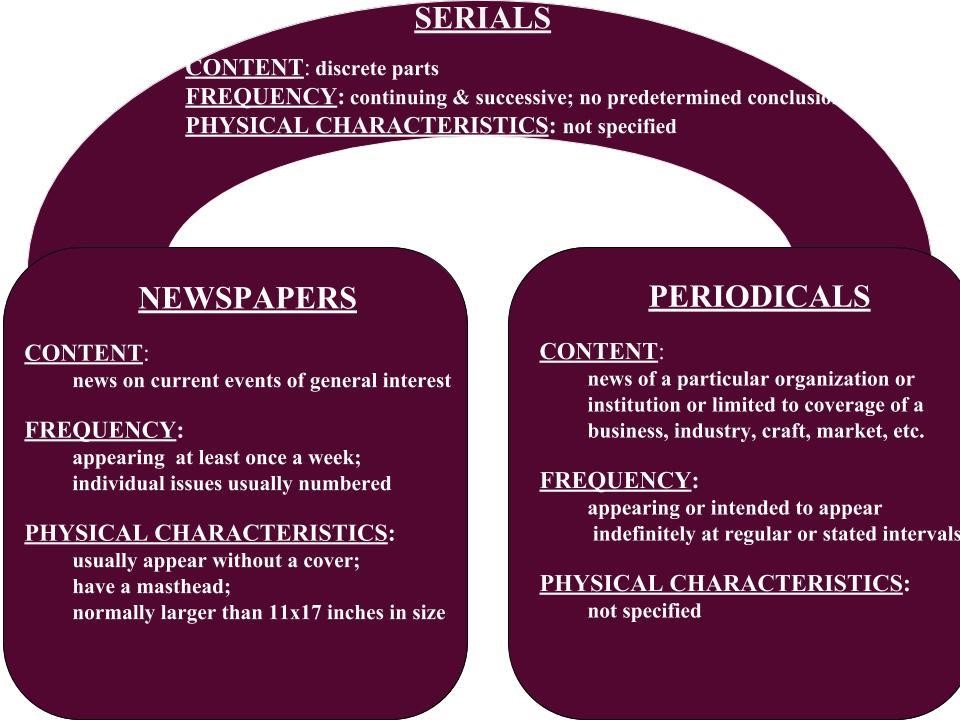 Figure 2. The differences between newspapers and periodicals, according to cataloging guidelines. Created by the authors.
Figure 2. The differences between newspapers and periodicals, according to cataloging guidelines. Created by the authors.
¶ 17 Leave a comment on paragraph 17 0 Serials cataloging is indeed intellectual labor; it is interpretive work and often subjective. Ultimately, cataloging determines where researchers will encounter the historical record. At AAS, the distinction between newspaper and periodical determines in which proprietary database an item will appear. If it is an article in a newspaper, then it becomes a part of Readex’s America’s Historical Newspapers. If it is an article in a periodical, then it becomes part of EBSCO’s Historical Periodicals Collection.
¶ 18 Leave a comment on paragraph 18 0 As we discussed above, the UMBC students had access to neither of these databases, relying instead on ProQuest’s American Periodicals, as well as free sources online. Importantly, the ProQuest database to which UMBC subscribes does not share the same holdings with the AAS’s EBSCO database, so our selection process required a comparison of these holdings. We turned this potential obstacle into a real learning opportunity by extensively discussing—between ourselves and then with students—how to read and interpret metadata to better understand how periodicals are cataloged differently across these platforms. Parsing the definition of “periodicals” from a cataloging perspective, then, was a critical first step in knowing where to find certain titles and articles. A brief history of classification was a necessary precursor to effective searching.
¶ 19 Leave a comment on paragraph 19 0 In many ways, by settling on the title “Mill Girls in Nineteenth-Century Print” for the online exhibition, we skirted the potential confusion of using “periodicals” or “serials.” But, this productive confusion allowed us to talk with students about how this classification came about in the first place. The nineteenth century did not make distinctions between newspapers and periodicals, as catalogers or academics do now, but because of postal regulations that made it far cheaper to send news than other types of publications or letters through the mail, popular and legal disputes over the definition of a newspaper abounded. Richard John writes that the Post Office Act of 1792 established “unusually favorable terms” for newspapers by admitting every newspaper into the mail for the nominal fee of one cent if travelling fewer than 100 miles, and one-and-a-half cents if it traveled a greater distance. This first federal postal act also codified free newspaper exchanges among printers, a customary practice for decades, into law.15 The early law can certainly be credited with the massive uptick in newspaper production and consumption in the first half of the nineteenth century, but it also led to gimmicks that were deceptive, if not illegal, as senders began to disguise other forms of communication as newspapers. Magazines, which were admitted into the mail in 1794, did not enjoy the same breaks as newspapers, though they were still cheaper to send than letters. “Predictably enough,” writes John, “enterprising printers of all kinds quickly adapted their publication to a newspaper format,” using the term “newspaper” to describe specific content for a specialized audience, even though based on such content, today’s cataloger would classify such “newspapers” as “periodicals.”16
¶ 20 Leave a comment on paragraph 20 0 Our own confusion over serials categories led us to investigate how the evolution of the postal service affected serials classification. The students needed to understand this distinction not only as a lesson in the longue durée of news circulation or as a lesson in why certain publications could be found in certain databases but also to understand results they came across in AAS’s own information infrastructure. At AAS, the distinction between newspapers and periodicals has consequences as well, and not just in terms of which stack holds the newspaper or periodical; in other words, the classification determines not just the call number and therefore paging of the physical object within the library itself but also the remote user of the online catalog. After the deep cataloging that results in the serial’s classification as either a newspaper or a periodical, newspapers are then put in a queue for inclusion into the AAS’s internal newspaper database, Clarence. Created to augment MARC, or Machine-Readable Cataloging, records that do not detail specific issue holdings, Clarence makes the AAS holdings clear at the issue level through a calendar visualization for each month that a holding exists. It also notes the condition of the newspaper, whether it is “whole,” “damaged,” or “has notes.”
¶ 21 Leave a comment on paragraph 21 0 Such issue-level recording used to be done on a national level through the U.S. Newspaper Program, which from 1982 to 2011 was a project funded by the National Endowment for the Humanities, with technical assistance from the Library of Congress. This project was in many ways a response to Bowers’s 1971 imperative with which we began: “[A] cooperative national effort among the states and the federal government to locate, catalog, and preserve on microfilm newspapers published in the United States from the eighteenth century to the present.”17 The work was largely conducted at the state level, but the NEH also funded the cataloging of newspapers at eight national repositories, including the AAS.18 This directory stopped updating holding information in the early 2000s, so any acquisitions since then are not recorded. For example, since he arrived at AAS in May 2002, Curator of Newspapers and Periodicals Vincent Golden has added 383,000 issues of 5,195 different titles, 2,052 of which were new to the AAS.19 None of these issues could be recorded in the U.S. Newspaper Directory. AAS did not want the information to be lost, however, and so they created Clarence, which captures titles collected since the AAS’s inception in 1812, as well as its most recent acquisitions. Using Clarence meant that Lindsay’s students could identify specific issues held in the AAS stacks and their material condition, an additional bit of information not provided in the periodicals metadata [Figure 3]. For example, students researching the 1857 financial panic found a cartoon on Wikipedia from Harper’s Weekly they thought relevant; using Clarence, they were able to determine that the AAS held the October 31, 1857 issue and then incorporate a photograph AAS provided of the cartoon for the exhibition’s timeline [Figure 4].
¶ 22
Leave a comment on paragraph 22 0
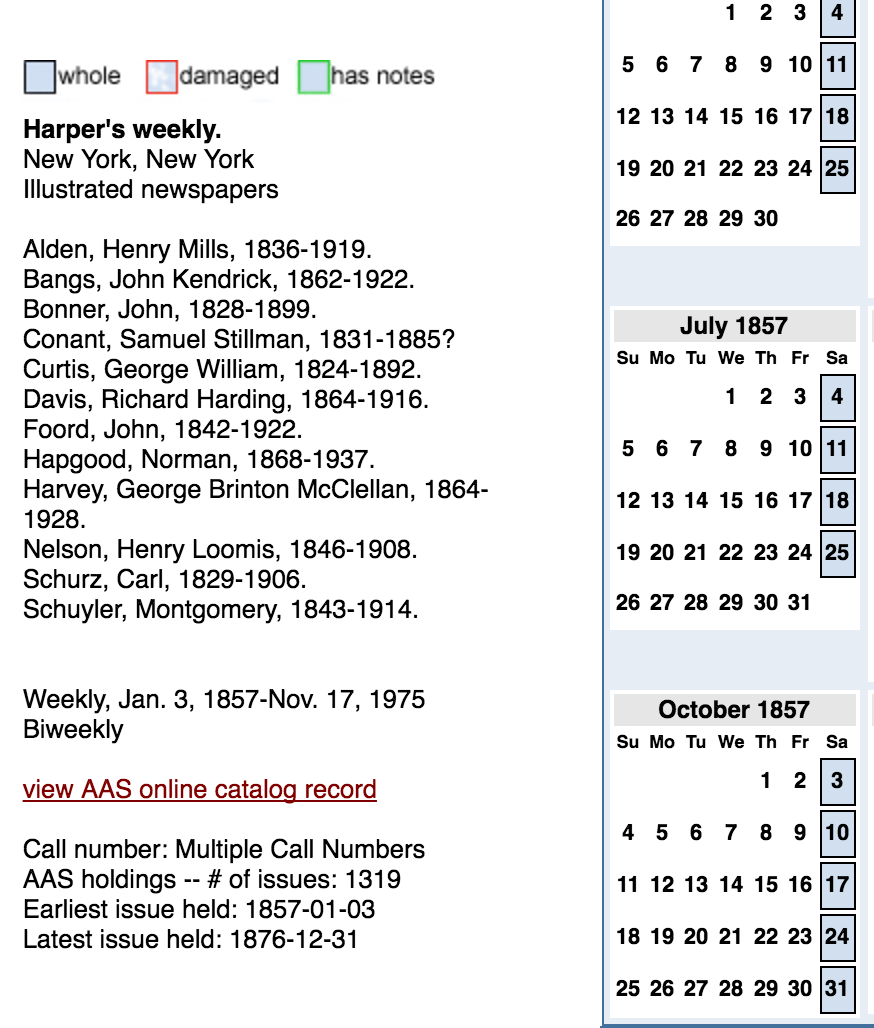 Figure 3. Results of Clarence search for Harper’s Weekly in AAS catalog.
Figure 3. Results of Clarence search for Harper’s Weekly in AAS catalog.
¶ 23 Leave a comment on paragraph 23 0
¶ 24 Leave a comment on paragraph 24 0
¶ 25
Leave a comment on paragraph 25 0
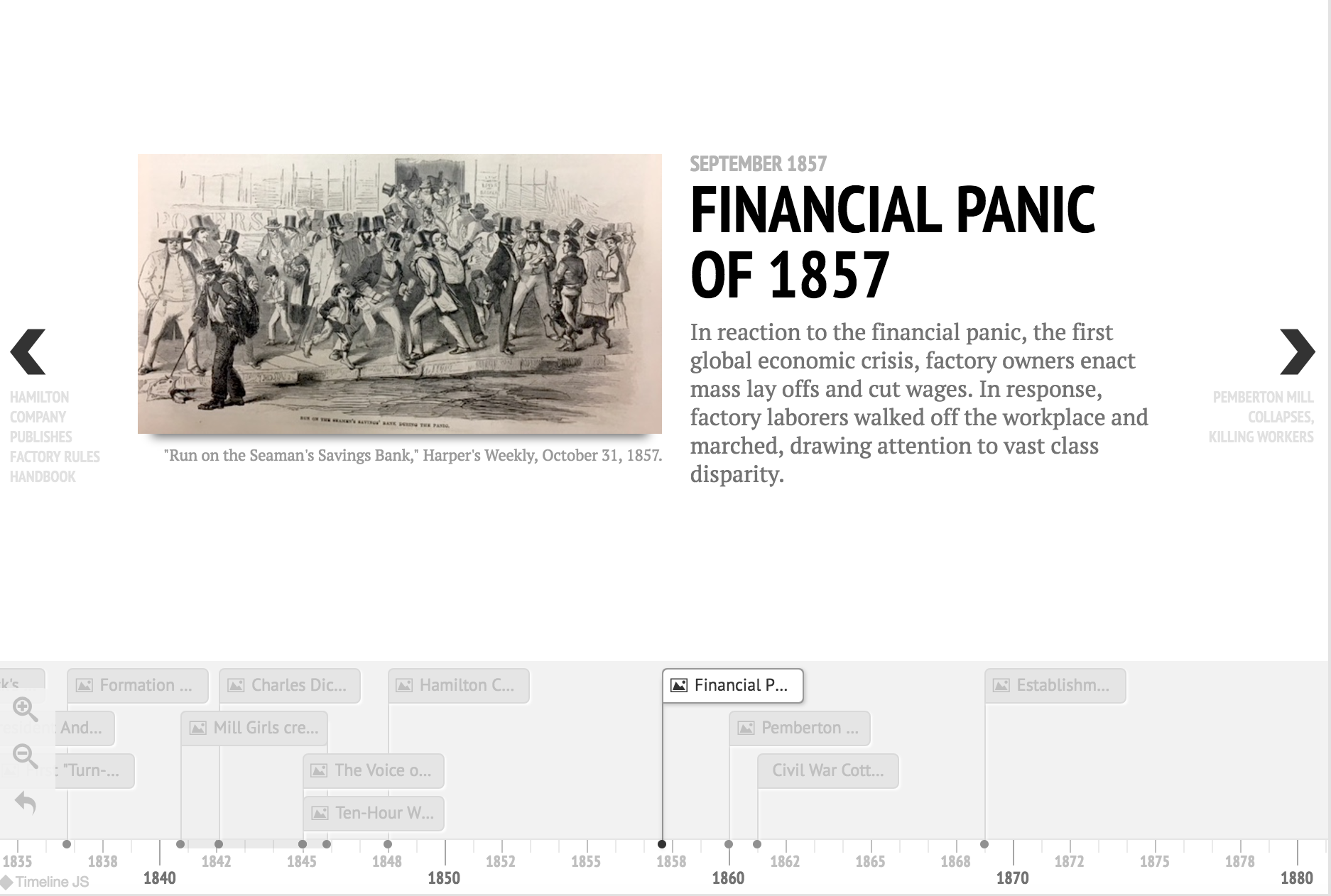 Figure 4. Students’ entry for this item on the “Mill Girls in Nineteenth-Century Print” timeline.
Figure 4. Students’ entry for this item on the “Mill Girls in Nineteenth-Century Print” timeline.
¶ 26 Leave a comment on paragraph 26 0
¶ 27 Leave a comment on paragraph 27 0 The students’ reliance on Clarence, just as their understanding of which serials could be found in which databases, was far from immediate. They had to first understand that they could only rely on this system when searching for newspapers, not for periodicals. Lindsay and Molly had to take the time to explain the differences, and in this instance as in many others, such explanations led to insights into the historical record and its circulation. The shifting nature of the serials production and distribution in the nineteenth century leads to a sort of bibliographic complexity that serials catalogers have been tasked with sorting out. But to the researcher, this can seem like a world of obfuscation. The process of interrogating our terms and our searches enabled us to bridge the gap that can divide cataloging work from scholarly use; this divide perpetuates the perception of “messy” periodicals work when, indeed, there is order in the chaos if the cataloger and researcher can communicate in the same language.
¶ 28 Leave a comment on paragraph 28 0
¶ 29 Leave a comment on paragraph 29 0 What’s in a Name?
¶ 30 Leave a comment on paragraph 30 0 Cataloging, housing, shelving—all the ordering systems that institutional preservation demands—are in many ways anathema to the reality of nineteenth-century serials, whose fluidity resists the stability of the library and the item-level records that are the scaffolding of any bibliographic information system. Put simply, one might find something online that doesn’t appear to exist in the library because that something’s information is recorded differently. One example of this inconsistency is the case of shifting serials titles, what catalogers record in the MARC 780 field for preceding titles and the 785 field for succeeding titles.20 The morphing of a given publication’s name, especially the subtitle, offers one such opportunity to explore the bibliographic record at the item level.
¶ 31 Leave a comment on paragraph 31 0 In their secondary reading, the students came across a citation for “Duties and Rights of Mill Girls” in the New England Offering. Hoping to find it for free online, they turned to Google, the seemingly omniscient interface [Figure 5].
¶ 32 Leave a comment on paragraph 32 0
¶ 33
Leave a comment on paragraph 33 0
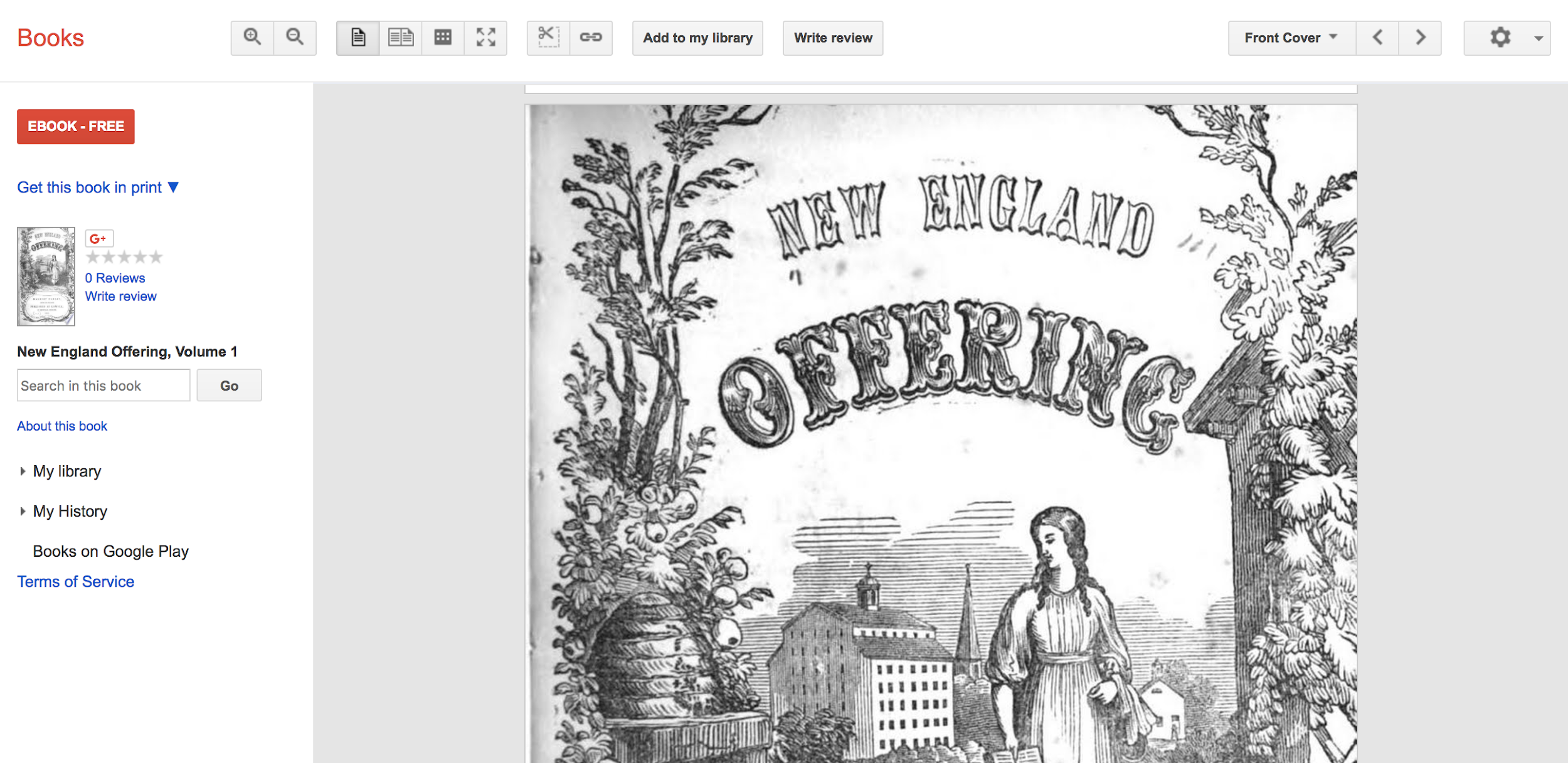 Figure 5. Screenshot of Google Books search result for “New England Offering, Volume 1.” Last visited August, 2018.
Figure 5. Screenshot of Google Books search result for “New England Offering, Volume 1.” Last visited August, 2018.
¶ 34 Leave a comment on paragraph 34 0
¶ 35
Leave a comment on paragraph 35 0
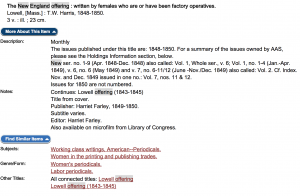 Figure 6. AAS catalog search result for “New England Offering.”
Figure 6. AAS catalog search result for “New England Offering.”
¶ 36 Leave a comment on paragraph 36 0 The students then found the article they sought and dutifully copied metadata into a shared spreadsheet we had set up for them so that Molly could rapidly find the item in the catalog and then in the collection. They requested images of Volume 1, pages two to six, of the April 1848 New England Offering. Importantly, the students had to tell Molly at AAS precisely what they needed. At first, they were not sure how to do so given the scant metadata in Google Books. The abundance of metadata in the AAS Catalog could also confuse the students. For example, a search for “New England Offering” in the AAS General Catalog yields two results, both the New England Offering and the Lowell Offering. Examination of the New England Offering record explains why: from 1843 to 1845 it resumed publication under the title Lowell Offering, which also used the same cover image [Figure 6].
¶ 37
Leave a comment on paragraph 37 0
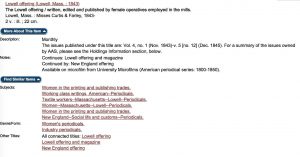 Figure 7. AAS catalog search result for “Lowell Offering and Magazine.”
Figure 7. AAS catalog search result for “Lowell Offering and Magazine.”
¶ 38 Leave a comment on paragraph 38 0 The Lowell Offering record reveals another title change: before it was the Lowell Offering from 1843 to 1845, it was the Lowell Offering and Magazine 18421843 [Figure 7].
¶ 39 Leave a comment on paragraph 39 0 The periodical then took a break before being reissued as the New England Offering from 1848–1850. And so, from the catalog records alone, which trace these changes through the MARC 780 and 785 subfield t, we can reconstruct these name changes. AAS Senior Cataloger S. J. Wolfe’s deep catalog records alone enable a kind of retracing and unearthing, a reconstruction of what might be lost if a researcher only consults Google Books’s New England Offering.
¶ 40 Leave a comment on paragraph 40 0 Questions about why nineteenth-century serials generally, and the New England Offering in particular, changed so frequently are outside the scope of the catalog as well as this article. AAS Curator Golden, who spends his professional life awash in this mire, is fond of remarking with a smile that “Nineteenth-century serials editors didn’t give a damn about the contemporary researcher.” With the considerable assistance of serials catalogers, researchers are left to organize, to unite and differentiate; but, without critically analyzing the available metadata, the researcher can become lost. In a collaborative project like ours, attention to metadata (or lack thereof in a platform like Google Books) allowed us to communicate across the physical gulf that separated our work and the digital gulf that separated our access to serials. In instances where students located an item for the exhibition on an open-access database but could not locate publication-level metadata, the AAS catalog played an absolutely critical role. In some cases, ProQuest’s metadata and the AAS catalog entry were inconsistent and required further scrutiny. The lesson behind changing serials titles, then, was just as much about the shifting landscape of nineteenth-century serials publishing as it was about the shifting landscape of twentieth-century serials cataloging and twenty-first century digital access. Here, again, we learned that the act of remediation required a critical awareness of cataloging history and media archaeology. Without this awareness, researchers may be inclined to simply reproduce the information that they find in one database—however errant, misleading, incomplete, or contradictory.
¶ 41 Leave a comment on paragraph 41 0
¶ 42 Leave a comment on paragraph 42 0 Clipping and Flipping
¶ 43 Leave a comment on paragraph 43 0 After students had located the items they wanted to use in the exhibition, they inputted the carefully constructed data from their shared spreadsheet into Omeka, a process that the “CSV Import” plug-in automates. Within each of three exhibition pages—”Culture,” “Conditions,” and “Activism and Reform”—they created subcategories for further categorizing their materials, organizational work that Omeka makes quite seamless. Inputting images of the articles—
¶ 44 Leave a comment on paragraph 44 0 along with the metadata describing them—into the exhibition pages required some theorizing about the visual representation of material texts. The students quickly realized that new high-resolution photographs of each article, rather than relying on digital scans of microfilm images, made for more accurate and visually appealing representations, and so they relied on AAS to provide such images. As a team working in two locations, we essentially worked backward from the usual trajectory—digitization from paper object to digital surrogate; instead, we found items in the digital databases first and then located and photographed them in the AAS stacks. To the degree that it is possible with the high-resolution image furnished by AAS, we aimed to represent the color and texture of the item and, in this way, restore some of the losses that Diana Kichuk’s work enumerates: page distortion, loss of detail, and bitonal reduction.21 Any researcher who has used serials databases can recognize the difference in quality between the high-contrast black-and-white ProQuest image and the newly photographed image of one sample from the exhibition, “Factory Girls on Strike,” printed in the New York Times on November 18, 1874. Of course, the ProQuest image bears the traces of its earlier instantiation as a microfilm image (ca. 1941) [Figure 8]. The visual contrast between the black print and white space in the ProQuest scan creates the impression of uneven inking.22 In the Times examples, the “o” in “condition” (line 11) is almost invisible in the ProQuest image [Figure 8] but the AAS photograph shows the “o” as faintly present [Figure 9]. David McKitterick describes how microfilming in the 1930s and 1940s transformed what researchers could see, or not see: “Pages were sometimes cropped in order to fit in the screen, exposure—especially in the early years—was variable. The resolution was deliberately set low. . . . Colour printing becomes black and white. Paper quality is indeterminable.” Also, the cropping of the ProQuest image eliminates the printer’s dividing ornament on the top and bottom of the article. The missing ornament is an example of what Kichuk calls “content amputation,” or the “accidental or deliberate gaps created for reasons of expediency, subjective production decisions, or inherent qualities of the medium” that are the now-digital inheritance of microfilm technology.23 Further, as Sarah Werner observes, digitally amputating the content of a book or serial page means that “only some of the cues of size remain,” which can elide details about a book or serial’s “intended use and about the economics of their production.”24
¶ 45 Leave a comment on paragraph 45 0
¶ 46
Leave a comment on paragraph 46 0
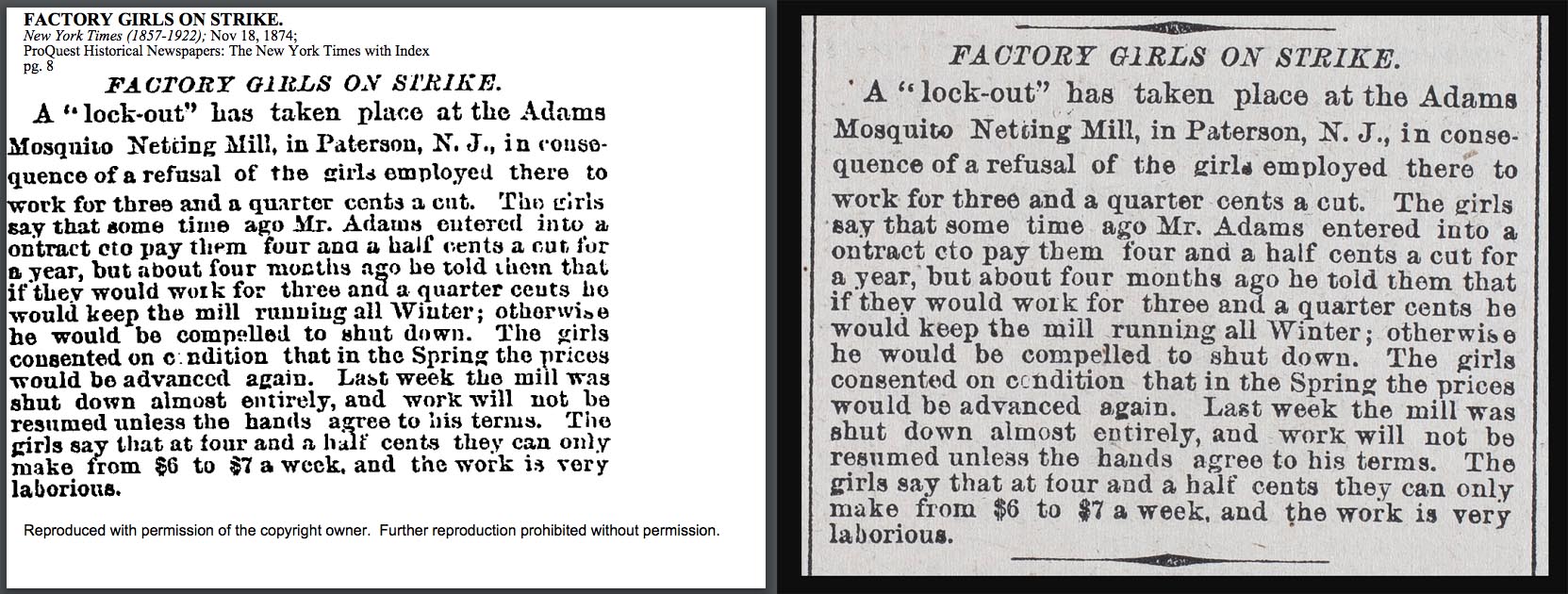 Figure 8 (left). “Factory Girls on Strike” article view from ProQuest Historical Newspapers.
Figure 8 (left). “Factory Girls on Strike” article view from ProQuest Historical Newspapers.
Figure 9 (right). Photograph of “Factory Girls on Strike” as it appears in “Mill Girls in Nineteenth-Century Print.” Courtesy of the American Antiquarian Society.
¶ 47 Leave a comment on paragraph 47 0 We performed our own “amputation” of sorts, electing to replicate the “clipping” style of the ProQuest image instead of photographing the entire newspaper page. Our decision was not based on expediency, however, but theories of newspaper reading. Digitizing a discrete article from the newspaper page reflects what Ellen Gruber Garvey identifies as the common practice of clipping. Garvey contends that readers and editors—and, eventually, clipping bureaus—saw newspapers as “extractable sources of data” that preview our own digital methods of “slicing and managing information.”25 In the context of the exhibition page titled “Organized Resistance,” the article view of “Factory Girls on Strike” is consistent with the nineteenth-century practice of clipping thematically linked articles and assembling them on a page. Students took a similar “clipping” approach in their documentation of mill accidents in the “Accidents and Negligence” section of the “Conditions” page. The effect of including a newspaper clipping attesting to “A Girl Torn to Pieces,” as one 1871 account read, is to illustrate “not only the poor conditions themselves, but also the reading public’s desire to peer into the tragedy. . . . These accounts usually depict the women as anonymous and, thus, replaceable, and often fail to report on the full extent of the fatalities,” as the students reflect in the explanatory text.26 Here, the form of the newspaper clipping itself reflects the public’s interaction with these stories: brief, titillating, horrifying, interchangeable.
¶ 48
Leave a comment on paragraph 48 0
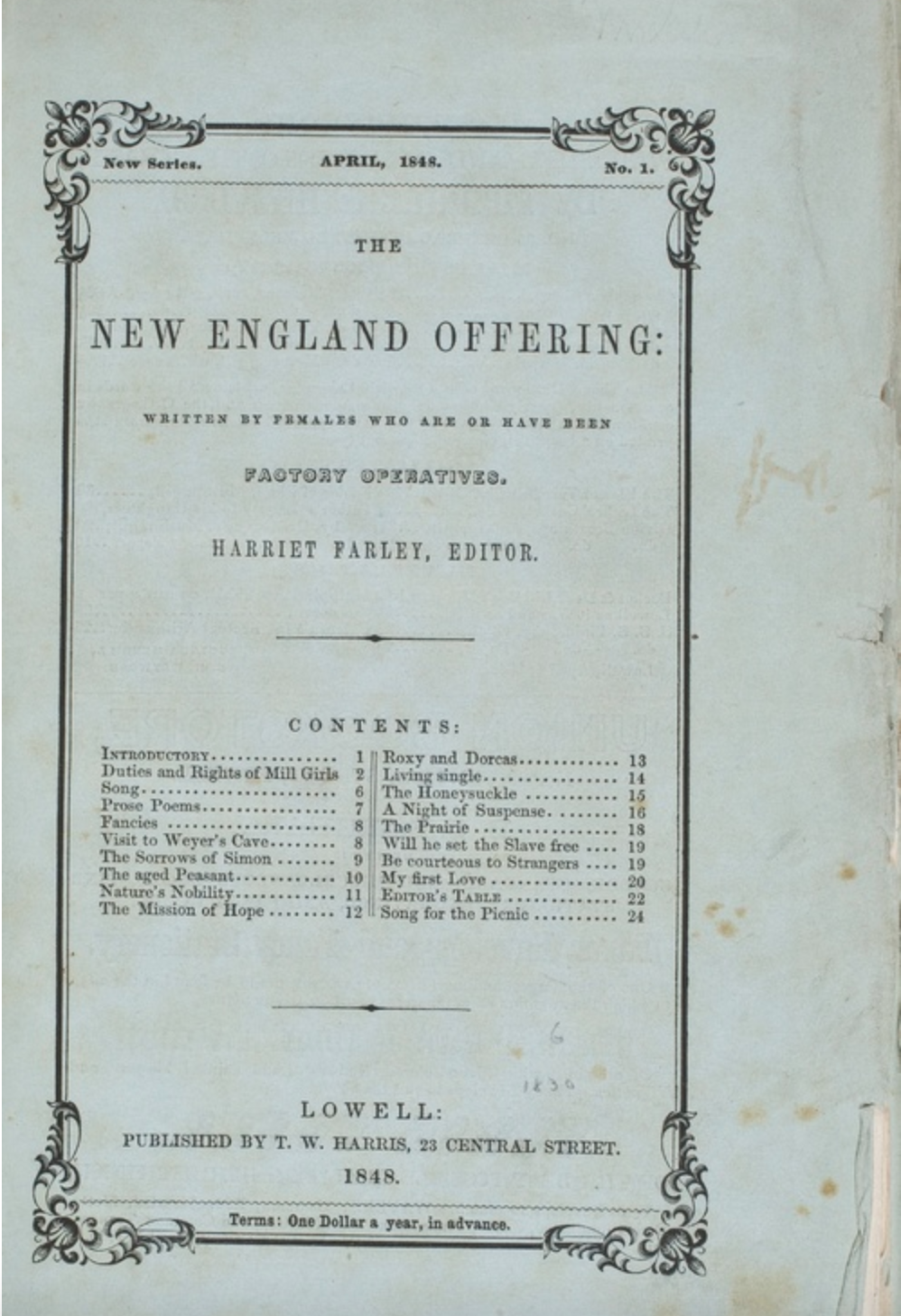 Figure 10. Photograph of the New England Offering, April 1848. Courtesy of the American Antiquarian Society.
Figure 10. Photograph of the New England Offering, April 1848. Courtesy of the American Antiquarian Society.
¶ 49 Leave a comment on paragraph 49 0 For other exhibition items, we elected to include and, indeed, attempt to reproduce whole articles in a codex form, capturing the reader’s experience of flipping through the pages of a magazine rather than, say, scrolling downward on a screen, as contemporary readers are used to doing. In the case of the New England Offering, noted above for its shifting titles, we had the luxury of photographing the issue with a blue wrapper [Figure 10]. Intact paper wrappers are rarely seen in digital serials databases because they are often missing from the issue altogether. Sometimes the wrappers are not there because of wear and tear or because of intentional removal from past readers. Often, they were tossed out in the process of binding annual volumes. Because databases like Google Books or HathiTrust have a tendency to scan these bound annual volumes of periodicals and not individual issues, users simply do not see the paper wrappers, advertising inserts, or other ephemera on their screens. As Mitch Fraas observes in his study of Blackwood’s Edinburgh Magazine, “Periodicals are particularly fluid material texts, often intended to be preserved in different formats than they were sold right from the start—think of those shelves of bound journals sitting in the stacks of university libraries, or even your old copy of the New Yorker missing all those annoying subscription cards.”27 Indeed, even in students’ work in UMBC Special Collections, they had not encountered many intact papers wrappers because of the methods used to bind annuals. Though paper wrappers on eighteenth- and nineteenth-century magazines were sometimes vehicles for advertising, in the case of the Offering, the blue wrapper functions as a title page. Our photograph of the issue in wrappers is an example of remediation but also of restoration, capturing something rarely observed in other digital representations of the New England Offering and hundreds of other periodical titles from this era. Viewing this issue in wrappers also invites the reader to consider the events of April 1848 that might have given shape to its contents. Indeed, it reminds readers of the seriality of this publication itself, a characteristic that can be obscured when readers encounter the Offering as a bound annual volume.
¶ 50 Leave a comment on paragraph 50 0 Finding the print ephemera that is discarded in the reading, binding, and/or scanning process is still an easier task than preserving the haptic qualities of serials. The easiest way for digital platforms to represent serials is to present them in vertical orientation, for ease of scrolling. In this instance of what Andrew Piper calls “double remediation,” (because digital platforms dismantle the book into individual pages and then reassemble it into a scroll), the reader is still faced with “single pages” presented one after the other, even if she no longer has to wait for individual pages to load (as in the early days of the web).28 The Internet Archive introduced its BookReader view for a reading experience that resembles flipping through a codex rather than scrolling vertically. The codex offers a fluidity of reading that is desirable in this context because not all pages are visible at once. As Lori Emerson describes, the codex “grant[s] access” to the page but “also inevitably acts as a kind of magician’s cape, continually revealing . . . through concealing and concealing as it reveals.”29 To recreate the experience of concealing/revealing the pages of an article entitled, “Duties and Rights of Mill Girls” in the New England Offering, we used a free tool called FLIP HTML that creates the impression of a dynamic, turning page, complete with a shadowed center crease and the sound effect of a page turning [Figure 11]. These visual and aural components, combined with the ability to “turn” the page, mimic the sensory experience of holding the magazine in one’s hands better than the act of vertically scrolling through flattened page images does. For articles that exceeded three or four page images, then, we used the tools of the “digital—in the electronic sense—[to] help us become, or remain, aware of the digital in the manual, historic sense,” as Leon Jackson so eloquently explains.30 What is missing from the metadata in this example, however, is a sense of the magazine’s size, the texture of the paper, or other haptic qualities that were beyond the scope of our abilities to capture. In each step of remediating “Duties and Rights,” we had to contend with the question of how this article’s previous instantiations (material and digital) also bore the traces of its own collecting and cataloging history, from its shifting indicator titles to its status as bound or unbound. But what happens when some step in that process is flawed?
¶ 51
Leave a comment on paragraph 51 0
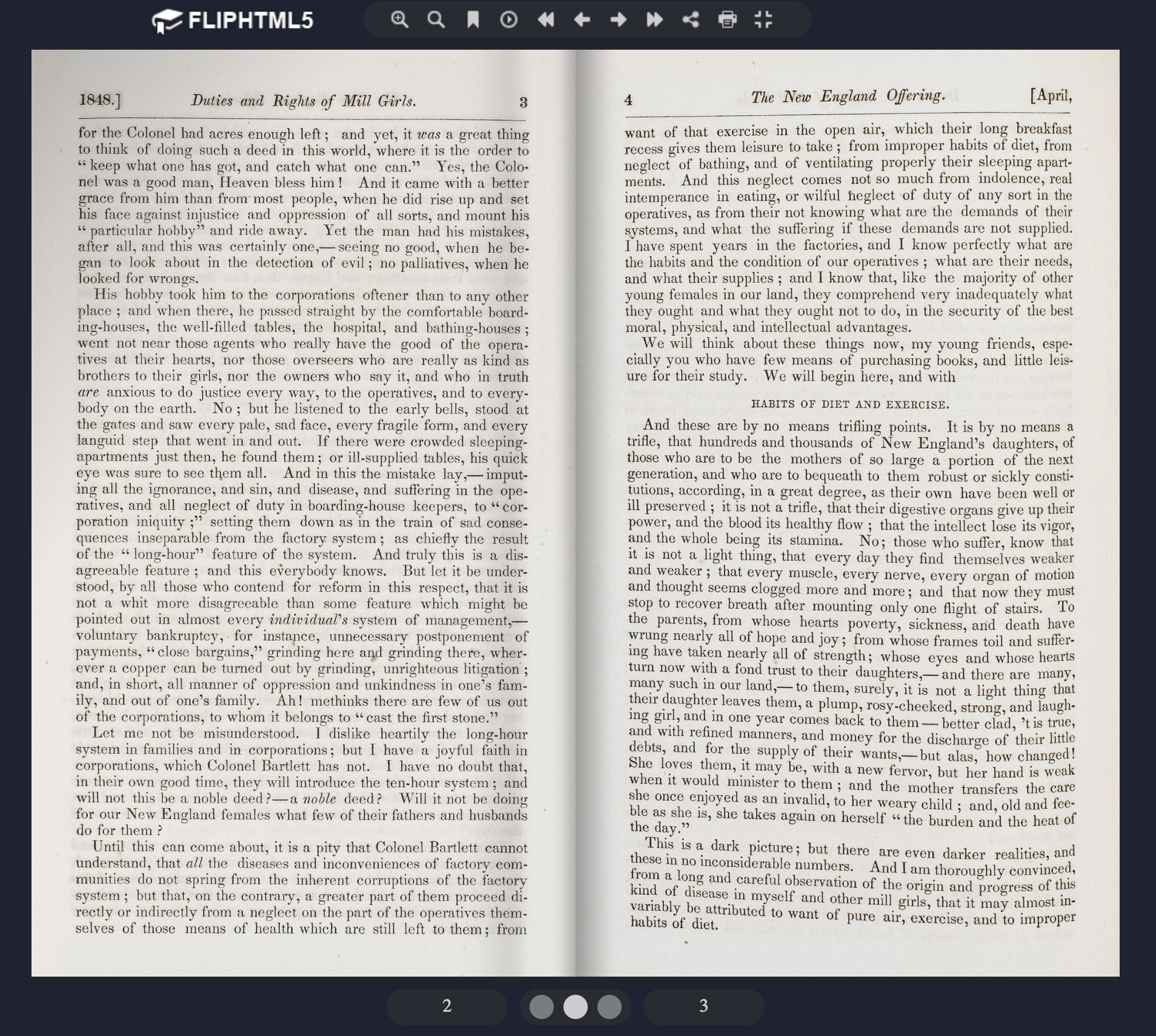 Figure 11. Still image of FLIPHTML edition of “Duties and Rights of Mill Girls.” http://online.fliphtml5.com/vprt/wupe/.
Figure 11. Still image of FLIPHTML edition of “Duties and Rights of Mill Girls.” http://online.fliphtml5.com/vprt/wupe/.
¶ 52 Leave a comment on paragraph 52 0
¶ 53 Leave a comment on paragraph 53 0 Imitation and (Mis)Citation
¶ 54 Leave a comment on paragraph 54 0 In a few cases where the AAS did not hold a specific newspaper or periodical issue in its stacks, particularly for rare labor newspapers like the Voice of Industry (the publishing organ of the Lowell Female Labor Reform Association), we created a mock version of a nineteenth-century newspaper article and used the serial’s masthead as a synecdoche for the missing issue. According to Clarence, the AAS holds thirty-six issues of this weekly, which ran from May 1845 to April 1848. Students had located an article titled “Ten Hours, Ten Hours!! Sign the Petition!” in a contemporary anthology of mill girl writings titled The Factory Girls (1977), edited by Philip Foner [Figure 12].31 The article was dated January 15, 1845, and when they checked that date against the Clarence holdings, they found that AAS did not have the issue. Using the text of the article reproduced in The Factory Girls anthology, then, a graduate student created a mock-up of the “Ten Hours” piece, attempting to match the look of the sepia-toned newsprint of the masthead, which Molly had photographed from the AAS archive [Figure 13]. The high-resolution photo of the masthead preserves the foxing on the paper as well as the slight bleed-through of ink from the back of the page, qualities that are difficult to replicate artificially without sophisticated design software. The mock-up version was our best attempt at creating an aesthetically consistent impression of the article. Though the photograph of the masthead communicates nothing about the size or paper quality of this labor newspaper, the vertical creases clue readers in to how the paper may have been handled and folded. (Indeed, as Jackson describes, digitally capturing the “historical haptics” of newspapers is tremendously challenging, though efforts to document printed materials’ size, paper weight, texture, and other haptic qualities are under way).32 These reproductions of “Ten Hours, Ten Hours!! Sign the Petition!” are misleading, however, and offer a cautionary tale for serials researchers.
¶ 55
Leave a comment on paragraph 55 0
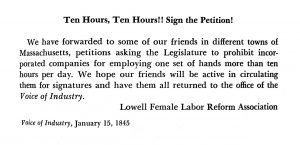 Figure 12. The article, “Ten Hours, Ten Hours!! Sign the Petition!” as it appears in Foner’s The Factory Girls (1977).
Figure 12. The article, “Ten Hours, Ten Hours!! Sign the Petition!” as it appears in Foner’s The Factory Girls (1977).
¶ 56 Leave a comment on paragraph 56 0
¶ 57
Leave a comment on paragraph 57 0
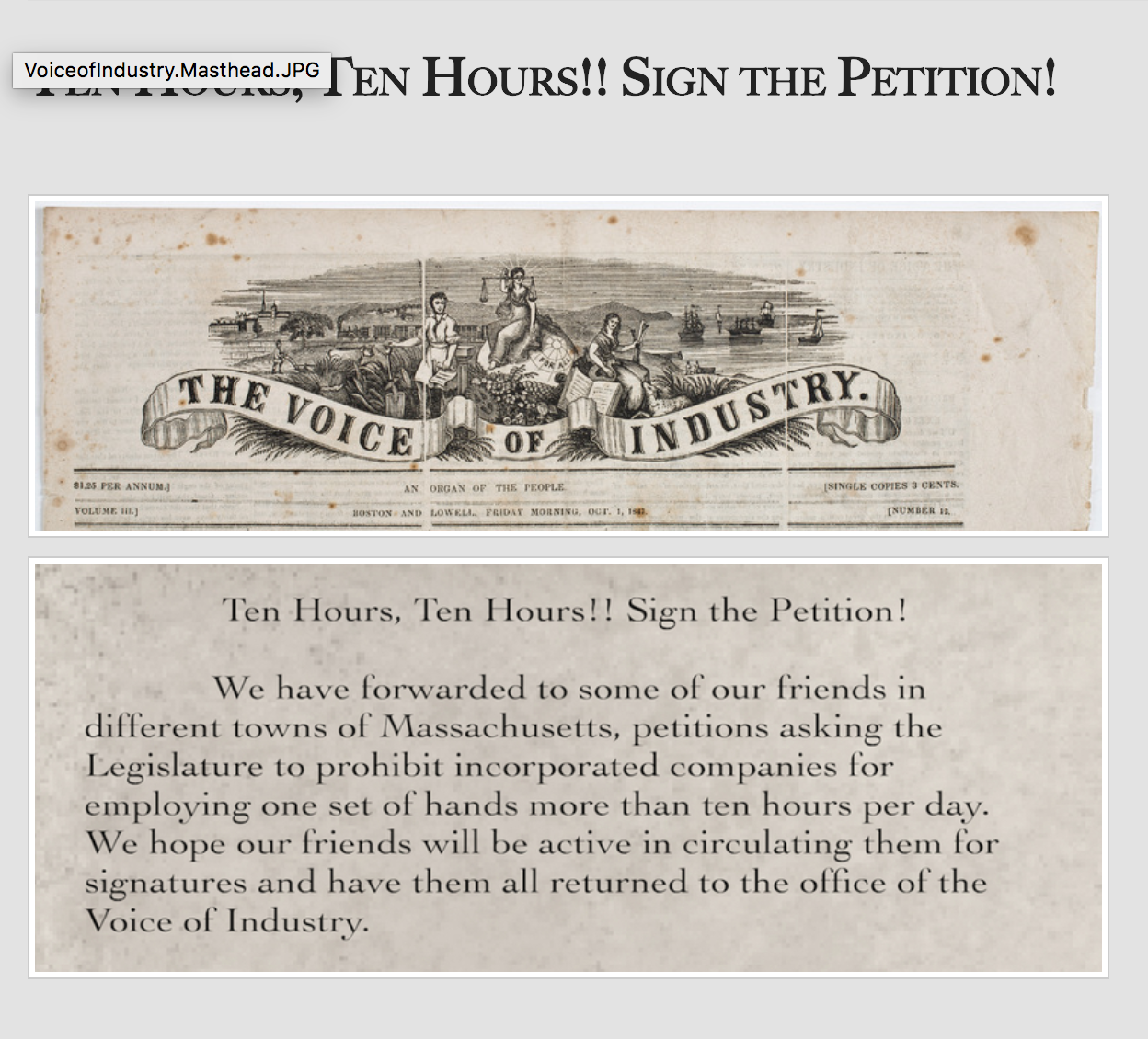 Figure 13. Photograph of the Voice of Industry masthead (courtesy of the American Antiquarian Society) and first, uncorrected version of “Ten Hours, Ten Hours!! Sign the Petition!” as created by students for the exhibition.
Figure 13. Photograph of the Voice of Industry masthead (courtesy of the American Antiquarian Society) and first, uncorrected version of “Ten Hours, Ten Hours!! Sign the Petition!” as created by students for the exhibition.
¶ 58 Leave a comment on paragraph 58 0 First, the stunning engraving on the masthead of the Voice of Industry was not added until February 1857, so it does not belong atop the 1845 article. This bit of anachronism, however, was an aesthetic choice that we made in order to capture the imagery of working-class solidarity (agriculture, manufacturing, shipping, the arts) so central to the paper’s ethos. The more serious revelation came when we dug a little deeper into the citation itself. The article in Foner’s anthology is dated January 15, 1845. However, the Voice of Industry’s inaugural issue was May 29, 1845. The January 15th date is impossible, and, indeed, the article does not appear to exist as anthologized. Neither did a companion article, the reprinting of “Petition to the Massachusetts Legislature,” signed by John Quincy Adams Thayer, Sarah G. Bagley, and “2,000 others mostly women,” which Foner’s bibliography claims was printed in the Voice of Industry on that same phantom date, January 15, 1845.
¶ 59 Leave a comment on paragraph 59 0 This example from the Voice of Industry yielded a lesson about the pitfalls of relying on a history of citations rather than of material sources. This case of remediation and citation gone wrong began with the students consulting a print anthology first. Foner writes in an editorial note that “all documents have been reproduced without substantive change, but misspellings and grammatical errors have been corrected if they appeared in printed sources and clearly were typographical mistakes.”33 He notes that he consulted several different special collections libraries and archives to compile the anthology, though we could not determine which archive held the Voice of Industry issues and articles that he chose to reproduce. After some searching, we found a digitized and moderately curated collection of the Voice of Industry on industrialrevolution.org, a site that features chronologically organized PDFs of the paper’s entire run and HTML transcriptions of selected articles. This same set of scans is available on the Internet Archive, but because of the poor condition of the images, keyword searching is unreliable. By reading these nearly illegible page images, we located a December 26, 1845 article entitled, “Ten Hours, Ten Hours!!” that bears a striking, though slightly altered, resemblance to the one reproduced in Foner’s collection [Figure 14].
¶ 60
Leave a comment on paragraph 60 0
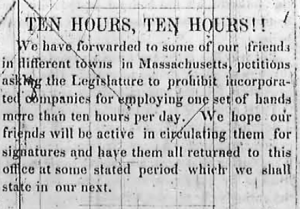 Figure 14. “Ten Hours, Ten Hours!!” in the Voice of Industry, December 26, 1845, from industrialrevolution.org; this site obtained their images in 2006 from an unknown source. The same set of images appears on the Internet Archive, posted there in 2013.
Figure 14. “Ten Hours, Ten Hours!!” in the Voice of Industry, December 26, 1845, from industrialrevolution.org; this site obtained their images in 2006 from an unknown source. The same set of images appears on the Internet Archive, posted there in 2013.
¶ 61 Leave a comment on paragraph 61 0 We could not find that the paper had ever reprinted the “Petition to the Massachusetts Legislature,” which was one of several that Sarah Bagley, editor of the Voice, circulated among laborers, although the paper’s editors issued follow-up calls for readers to sign the circulating petitions and return them to the offices of the Voice by January 20th, 1846 [Figure 15].34 Indeed, editors of the Voice frequently discussed the subject of the Ten-Hours Movement, but we could not locate the text of the petition itself in any issue published around the time of their submission to the legislature.
¶ 62
Leave a comment on paragraph 62 0
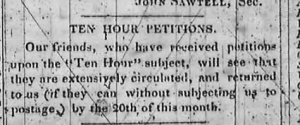 Figure 15. A January 9, 1846 article in the Voice of Industry, posted on industrialrevolution.org., asking for readers to “extensively” circulate and then return the “Ten Hours” petition.
Figure 15. A January 9, 1846 article in the Voice of Industry, posted on industrialrevolution.org., asking for readers to “extensively” circulate and then return the “Ten Hours” petition.
¶ 63 Leave a comment on paragraph 63 0 We were not able to determine the origin of the dating error, and rectifying it was also a challenge. As is often the case with digitized serials, the images are derived from microfilm and difficult to read or search; according to the metadata for this microfilm set, these images came out of the Harvard Library and were distributed by the State Historical Society of Wisconsin, whose collection of newspapers is the “second largest in the United States.”35 Based on only scattered holdings of the Voice in U.S. libraries, it would be very difficult for a researcher to look at the whole print run in hard copy. Perhaps this lack of access, especially before a site like industrialrevolution.org made the microfilm-derived PDFs available online, explains why Foner’s 1977 production of the errant articles related to the Ten-Hours petitions have been cited time and time again by other scholars. For instance, Alice Kessler-Harris’s 1982 history of women’s wage labor repeats the January 15, 1845 date, as does Janet Greenlees’s 2007 work Female Labour Power, Dorceta Taylor’s 2009 environmental study of American cities; Benjamin Powell’s 2014 book on sweatshops; even industrialrevolution.org, the very site that features PDFs of the newspapers, reproduced Foner’s exact content (without citing him) despite having evidence to the contrary in their online archive [Figure 16].36 Notably, none of these citations include page numbers for the alleged article in the Voice of Industry, raising the problem in academic publications of inconsistent citation practices and protocols for newspapers versus periodicals, not to mention opaque protocols about how and when to cite a paper, microfilm, or digitized edition of a serial publication.
¶ 64
Leave a comment on paragraph 64 0
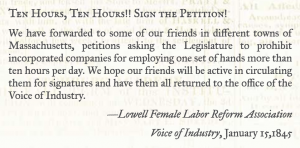 Figure 16. Industrialrevolution.org’s reproduction of the errant “Ten Hours” article. This site took a similar approach to ours by reproducing articles with an aesthetic resemblance to the originals, even decreasing the opacity of the background wallpaper to mimic ink bleeding through the page.
Figure 16. Industrialrevolution.org’s reproduction of the errant “Ten Hours” article. This site took a similar approach to ours by reproducing articles with an aesthetic resemblance to the originals, even decreasing the opacity of the background wallpaper to mimic ink bleeding through the page.
¶ 65 Leave a comment on paragraph 65 0 This one example of miscitation does not invalidate Foner’s work or the rigorous scholarship of these studies. What it does make clear is the degree to which lack of access to this particular newspaper led to the circulation of wrong information. This problem could have been rectified by consulting the Voice of Industry in print, on microfilm, or online after 2006 when it became available. Even more simply, the problem could have been rectified by consulting a library catalog, where the metadata for the Voice of Industry lists the inaugural issue as May 1845. The problem is that scholars who went on to cite the “Ten Hours” and “Petition” pieces were, ostensibly, pretending to cite the archive when, in fact, they were citing Foner’s book or perhaps each other’s books. More broadly, we faced the problem of “noncitation” that Meaghan Brown, Paige Morgan, and Jessica Otis identify in their work on citation practices in early modern scholarship. As Brown et al. observe, the practice of citation in the age of digital reproduction can lead to a kind of “invisibility” of nonprint sources altogether, due to the “higher social cachet” for citing print sources.37 Scholars are expected to consult printed serials, but such work is expensive and time-consuming; they have come to rely on digital surrogates or, as in our case, a dated print anthology or a string of citations. To untangle this Gordian knot required time and patience as well as knowledge of how to interrogate the archive; students had to learn to read catalog metadata, to track down scholarly citations, to wade through the digitized microfilm scans of a deteriorated newspaper. This process yielded more than just a corrected citation, of course. It clarified the importance of mooring serials research to physical collections, ensuring that what scholars read and cite is rooted in the archive itself and not only in a string of simulations or empty referents. Almost fifty years ago, Bowers warned that scholars sometimes possess a “fatal innocence that accepts the authority of the details of any document without having traced its textual transmission and the effect of this process on its words.”38 Students are not often taught to question the primary source material that they encounter, but the process of remediating texts for the exhibition required ours to take a critical and analytical posture toward their searches and their results, to shed that “fatal innocence” that can lead to the perpetuation of error.
¶ 66 Leave a comment on paragraph 66 0
¶ 67 Leave a comment on paragraph 67 0 Critical Cataloging
¶ 68 Leave a comment on paragraph 68 0 Beyond the lessons we learned about serials research and exhibition building, we were also left asking ourselves about the productive but sometimes strained relationship between the work of media classification broadly, and literary studies. Much of what we have described might seem the purview of an information science class and not an English class. Yet, the intense focus on process—not only the students’ process of remediating nineteenth-century serials but also on processes that came before to create the disparate and uneven digital collections on which they relied—was what made this class and, we hope, the Mill Girls exhibition so fruitful. Instead of perpetuating a divide between media studies or library science and literary research, we drew them together. Instead of teaching them the theories of media archeology, we took them on a site dig.
¶ 69 Leave a comment on paragraph 69 0 To return to Bowers, in 1952 he addressed the concern that bibliography was losing touch with literary studies, that the practice of bibliography was becoming arcane and “an end in itself.” Indeed, he argued that enumerative bibliography, as distinct from critical bibliography, should be used in service to “humane studies.”39 Bowers characterized this work as not only urgent—recall his worry, “time is running out”—but also necessarily cooperative, bridging gaps between disciplines and between information systems that don’t communicate with one another.40 To some extent, the NEH’s U.S. Newspaper Program and subsequent Chronicling America have fulfilled Bower’s call, but as previously noted, the U.S. Newspaper Program is now defunct. Chronicling America competes, in effect, with the proprietary database companies—EBSCO, ProQuest, and Readex—for content. Once these companies and archival institutions sign contracts, the content becomes unavailable for large-scale open-access consumption, and the tyranny of the paywall reigns supreme. Lindsay’s class could not use the AAS’s periodical or newspapers database for research even as they collaborated with the AAS staff for their project. Beyond profit motive, these companies have little incentive to share the data or metadata that they amass, and so they cannot be viewed as part of the collaborative effort that Bowers envisioned.41
¶ 70 Leave a comment on paragraph 70 0 Even with unprecedented access to digitized serials, we have made little progress in sharing the “messy” work of serials cataloging since 1971. As Vincent Golden detailed at an MLA talk in 2016, no comprehensive bibliography of United States serials exists after Clarence Brigham’s ends in 1820, and as Bowers notes, no single person will be able to do this work.42 The cataloging at the AAS and other large serials repositories is crucially important, but that work is no longer shared across institutions in any meaningful way. Further, the conversations around serials cataloging must also include a critical component, a close attention to the history of catalog construction and to the decisions that we have inherited from previous generations of catalogers and researchers alike. By digging through the content and history of serials cataloging, we illuminate the interconnectedness of nineteenth-century media history, twentieth-century classification and reproduction, and twenty-first century digital reproductions and citation practices. As we hope to have modeled throughout our reflections here, collaborations between academic scholars and libraries bear greater fruit than just content generation. They encourage a much-needed conversation about the history of the information systems we have inherited. Such systems are tethered to our understanding of the historical record and integral to making meaning from the content we encounter. If we are to do more than decry the chaos, then digital remediation of nineteenth-century serials content demands our attention to process, both our own and that of our predecessors.
- ¶ 71 Leave a comment on paragraph 71 0
- The authors would like to thank Vincent Golden, Will Slauter, Amy Sopcak-Joseph, and the two anonymous readers for their helpful suggestions. [↩]
- “Four Faces of Bibliography,” Papers of the Bibliographical Society of Canada 10, no. 1 (1971): 36. Counter to Bowers’s claims of newspapers’ eminent deterioration, Nicholson Baker somewhat controversially contended in Double Fold: Libraries and the Assault on Paper, that paper is far less fragile than some scholars, archivists, or librarians have assumed; indeed, he argues that the mass microfilming of newspapers has posed a greater existential threat to newspaper collections than their own physical properties. See chapter 1 of Double Fold (New York: Random House, 2001). [↩]
- The focus of our work here is nineteenth-century U.S. serials, though our scholarly and pedagogical wanderings into other centuries and locations indicate similar needs. [↩]
- Ryan Cordell, “What Has the Digital Meant to American Periodicals Scholarship?” American Periodicals 26, no. 1 (2016): 5. [↩]
- Patrick Leary, “Response: Search and Serendipity,” Victorian Periodicals Review 48, no. 2 (2015): 268. [↩]
- We use “remediation” to mean the “representation of one medium in another,” as defined by Jay David Bolter and Richard Grusin, Remediation: Understanding New Media (Cambridge, Mass.: MIT Press, 1999), 45. [↩]
- “Introduction to Nineteenth-Century Periodicals,” BLT19: Nineteenth-Century Business, Labour, Temperance, and Trade Periodicals, accessed April 8, 2019, https://www.blt19.co.uk/educators/introduction-to-19th-century-periodicals/. [↩]
- For more details on the collaborative project, see Hardy and DiCuirci, “Mill Girls in Nineteenth-Century Print: AAS Collections Meet DH Pedagogy,” Past Is Present: The American Antiquarian Society (blog), January 28, 2016, accessed April 20, 2019, https://pastispresent.org/2016/digital-humanities-2/mill-girls-in-nineteenth-century-print/. [↩]
- Paul Fyfe, “An Archaeology of Victorian Newspapers,” Victorian Periodicals Review 49, no. 4 (2016): 548. [↩]
- Fyfe, “Archaeology,” 546. [↩]
- Wolfgang Ernst, Digital Memory and the Archive, ed. Jussi Parikka (Minneapolis: University of Minnesota Press, 2013), 28. Ernst also identifies microfilm as system with a revealing history, and Bonnie Mak offers a model for the critical reading of the transformation from microfilm to digital proprietary database in the making of Early English Books Online. Mak identifies “clues—paratextual and peritextual; formal and material—[that] may be drawn together and scrutinized to develop a more nuanced understanding of that digitization and its politics, for it is within such an infrastructure that meaning is made.” “Archaeology of a Digitization,” Journal of the Association for Information Technology and Science 65 (August 2014): 1515. [↩]
- George Bowker and Susan Leigh Star, Sorting Things Out: Classification and Its Consequences (Cambridge: MIT Press, 2000). [↩]
- “Module 2.1 What Is a Serial?” Cooperative Online Serials Program (CONSER) Cataloging Manual, 2002. Updated 2006, accessed August 14, 2018, https://www.itsmarc.com/crs/mergedprojects/conser/conser/module_2_1__ccm.htm#2.1.2a.__Periodicals. [↩]
- Entry for “newspaper” in “DCRM(S): Descriptive Cataloging of Rare Materials (Serials),” website for RBMS: Rare Books & Manuscripts Section, ACRL, September 25, 2014, 194, accessed August 20, 2018, http://rbms.info/dcrm/dcrms/. [↩]
- Richard R. John, Spreading the News: The American Postal System from Franklin to Morse (Cambridge: Harvard University Press, 1995), 31. [↩]
- Ibid., 39. Printers were not alone in masquerading their communications as “newspapers” to save on postage. David M. Henkin chronicles how between the first postal act and 1851, when the cost of sending private correspondence was reduced, senders would attempt to disguise their personal notes by writing them in the margins and blank spaces of newspapers. Posting the epistle as a newspaper saved money and blurred the lines between a newspaper and other forms of communication. The practice became so ubiquitous that the law intervened: in 1825, Henkin notes, “Congress sought to suppress the habit of writing on newspaper by subjecting such papers to letter postage (typically paid by the addressee) and imposing a fine (on the sender) for the attempted evasion of the law.” And yet, Henkin finds ample evidence to support his claim that “the practice persisted” until 1851. David M. Henkin, The Postal Age: The Emergence of Modern Communications in Nineteenth-Century America (Chicago: University of Chicago, 2006), 47. For details of the 1851 act, see Richard Kielbowicz, News in the Mail: The Press, Post Office, and Public Information, 1700–1860s (New York: Praeger, 1989), 86–89. [↩]
- “U.S. Newspaper Program,” National Endowment for the Humanities website, accessed August 19, 2018, https://www.neh.gov/us-newspaper-program. [↩]
- Each of these libraries has extensive newspaper collections containing titles from most of the fifty states. The Library of Congress, with its own fiscal resources, also participated in the USNP as a national repository. This project was separate from the National Digital Newspaper Program (NDNP), which resulted in Chronicling America and which focuses on the digitization of texts rather than the creation of issue-level metadata. In addition to the tens of thousands of records dispersed throughout OCLC, the most visible, discrete outcome of the U.S. Newspaper Project is the U.S. Newspaper Directory, the most complete record of newspaper holdings at the issue level, but one that remains woefully outdated. “U.S. Newspaper Directory, 1690–Present,” accessed August 18, 2018, https://chroniclingamerica.loc.gov/search/titles/. [↩]
- Numbers reported by Golden in email correspondence with Hardy on April 29, 2019. [↩]
- “MARC 21 Format for Bibliographic Data: 76X–78X: Linking Entries-General Information (Network Development and MARC Standards Office, Library of Congress),” Library of Congress website, accessed August 19, 2018, http://www.loc.gov/marc/bibliographic/bd76x78x.html. [↩]
- Diana Kichuk, “Metamorphosis: Remediation in Early English Books Online (EEBO),” Literary and Linguistic Computing 22, no. 3 (2007): 299. [↩]
- David McKitterick, Old Books, New Technologies: The Representation, Conservation and Transformation of Books since 1700 (Cambridge: Cambridge University Press, 2013), 10. McKitterick notes that even more lamentable than the condition of the microfilm images, however, is the implication that one scan can stand in for all copies of the print artifact. Not only is the ability to compare multiple copies foreclosed upon, but researchers depending on a single copy may inadvertently repeat the same error if they have only consulted a single image (e.g., EEBO). [↩]
- Kichuck, “Metamorphosis,” 298. [↩]
- Sarah Werner, “Sizing Books Up,” The Collation: Research and Exploration at the Folger, July 10, 2013, accessed August 1, 2018, https://collation.folger.edu/2013/07/sizing-books-up/. [↩]
- Ellen Gruber Garvey, Writing with Scissors: American Scrapbooks from the Civil War to the Harlem Renaissance (Oxford: Oxford University Press, 2013), 229. [↩]
- “Accidents and Negligence,” Mill Girls in Nineteenth-Century Print, hosted by the website of the American Antiquarian Society, accessed April 20, 2019. https://www.americanantiquarian.org/millgirls/exhibits/show/working/conditions/accidents. [↩]
- Mitch Fraas, “What’s Missing in Magazines,” Unique at Penn (blog), posted September 24, 2015, accessed August 1, 2018, https://uniqueatpenn.wordpress.com/2015/09/24/whats-missing-in-magazines/. Fraas notes that while libraries are partially to blame for the excision of ephemeral materials from periodicals (usually for the purposes of binding), the magazines were actually bound in such a way as to “separate their meaty reading material from advertisements,” with the advertising material appearing “outside of the gathering structure of the issue,” not unlike those “annoying subscription cards in magazines today.” For further discussion of what is lost in the process of digitizing bound and unbound magazines, see Koenraad Claes, “Notes on the Material Periodical, Inspired by a Workshop in Ghent,” The Lady’s Magazine (1770–1818): Understanding the Emergence of a Genre (blog), November 13, 2015, accessed August 8, 2018. https://blogs.kent.ac.uk/ladys-magazine/2015/11/13/notes-on-the-material-periodical-inspired-by-a-workshop-in-ghent/#_ftnref1. [↩]
- Andrew Piper, Book Was Here: Reading in Electronic Times (Chicago: University of Chicago Press, 2012), 52. [↩]
- Lori Emerson, Reading Writing Interfaces: From the Digital to the Bookbound (Minneapolis and London: University of Minnesota Press, 2014), x. [↩]
- Thank you to Leon Jackson for sharing his paper, “Historical Haptics,” from the Digital Antiquarian Conference, American Antiquarian Society, Worcester, MA, May 2015. [↩]
- The anthology’s lengthy subtitle is: “A collection of writings on life and struggles in the New England factories of the 1840s by the Factory Girls themselves, and the story, in their own words, of the first trade unions of women workers in the United States.” Philip S. Foner, ed., The Factory Girls (Urbana: University of Illinois Press, 1977). [↩]
- Jackson, “Historical Haptics.” See, for example, Stefania Forlini, Uta Hinrichs, and John Brosz, “Mining the Material Archive: Balancing Sensate Experience and Sense-Making in Digitized Print Collections,” in “Remaking Collections” special issue, Open Library of Humanities (April 25, 2018), accessed November 23, 2018, https://olh.openlibhums.org/articles/10.16995/olh.282/. [↩]
- Foner, The Factory Girls, ix. [↩]
- The Ten-Hours petitions to the Massachusetts State Legislature referenced in the late 1845 and early 1846 articles of the Voice appear to be numbers 1587/9 and 1587/9. [↩]
- “About Our Microfilm Collection,” Wisconsin Historical Society (website), accessed August 1, 2018, https://www.wisconsinhistory.org/Records/Article/CS4008. [↩]
- Alice Kessler-Harris, Out to Work: A History of Wage-Earning Women in the United States, 2nd ed. (Oxford: Oxford University Press, 2003); Janet Greenlees, Female Labour Power: Women Workers’ Influence on Business Practices in the British and American Cotton Industries, 1780–1860 (Hampshire, England: Ashgate, 2007); Dorceta Taylor, The Environment and the People in American Cities, 1600s–1900s (Durham: Duke University Press, 2009); Benjamin Powell, Out of Poverty: Sweatshops in the Global Economy (Cambridge: Cambridge University Press, 2014). [↩]
- Meaghan Brown, Paige Morgan, and Jessica Otis, “Identifying Early Modern Books: Challenges for Citation Practices in Book History and Early Modern Studies,” Archive Journal (November 2017), accessed August 8, 2018, http://www.archivejournal.net/essays/identifying-early-modern-books/. [↩]
- Bowers, “Four Faces,” 45. [↩]
- Fredson Bowers, “Bibliography, Pure Bibliography, and Literary Studies,” The Papers of the Bibliographical Society of America 46, no. 3 (1952): 207. [↩]
- Bowers, “Four Faces,” 36. [↩]
- The savvier companies are creating packages for the purchase of their data and metadata; but even still, such use is exclusive and comes with strict regulations against sharing the data or metadata the researcher or research university library has purchased. See, for example, Gale Cengage’s promotion of its Data Mining and Textual Analytics products on its website at https://www.cengage.com/search/showresults.do?N=197+4294891079. For an excellent summary of how various vendors are handling data mining requests, see University of Texas at Austin librarian Susan Macicak’s LibGuide “Linguistics: Resources for Textual Analysis,” University of Texas Libraries website, https://guides.lib.utexas.edu/c.php?g=494168&p=5637765. [↩]
- Vincent Golden, “The Dark Ages of Newspaper Bibliography,” (paper presented at the Modern Language Association Annual Conference, Austin, TX, January 7, 2016). [↩]


